not a Chocolate?
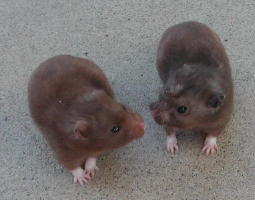
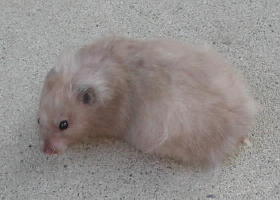
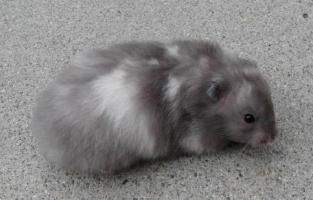
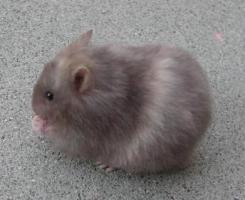
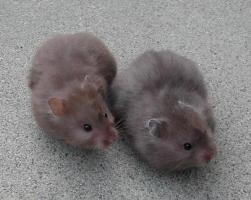
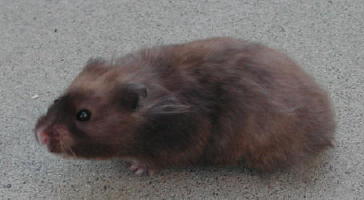
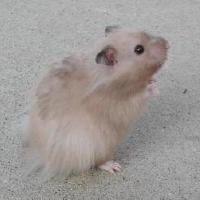
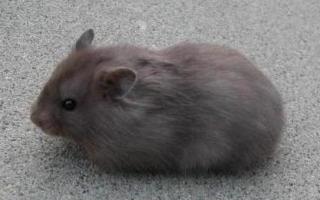
Chocolate is the color name reserved for a syrian hamster who is the combined color of Rust and Black. Genetically, it's aabb. They come in long haired, short haired, banded, dominant spot, tortoiseshell, satin and every other variation available in Syrian hamsters -- and they can be combined with any other color genes. The color is described as "dark chocolate brown" in both the BHA and the NHC standards.
Question: Which of the above pictures depicts an aabb Chocolate hamster? I'll give you a hint. Fewer than half of the animals above are aabb Chocolates.
Answer: The only three aabb Chocolates are the one on the left in the top left photo, the tortoiseshell in the photo second down on the right, and the hamster on the right in the pairing third down on the left.
What then are the other hamsters?
The other hamsters are all examples of the Extreme Dilute (ED) gene combined with Black. All are long haired except the two in the upper left photo.
In order the hamsters in the photos are
Left Photos Right Photos
Chocolate / Homozygous ED Black Males Heterozygous ED Black Female
Homozygous ED Black Tortoiseshell Pup Chocolate Tortoiseshell Pup
Chocolate / Homozygous ED Black Pups Homozygous ED Black Satin Female
Heterozygous ED Black Male Homozygous ED Black Pup
So what is the Extreme Dilute gene?
It is a relatively new gene which has become common along the East Coast of the U.S (mostly in the Mid-atlantic states). Its origins are unknown. The River Road Hamstery has been working since 1999 to document and establish this gene. Some Extreme Dilutes were sent to California in the Spring of 2003 from The River Road Hamstery, and all of the above ED animals are either animals shipped here or their pups.
Genetics of the Extreme Dilute Gene
From The River Road Hamstery's site (used with permission):
Extreme Dilution is a type of partial albinism that is known in mice. It prevents formation of most of the yellow-red pheomelanin pigment, changing what remains to shades of cream. Brown-black eumelanin is slightly diminished. Since the Syrian phenotypes of both homozygotes and heterzygotes matched those in mice almost exactly, and the genetic locus was identical, the name was adopted for use in Syrians. (Complete proofs can be found at Experimental Proofs of Gene Character and Transmission.)
The mutation is a C locus gene with the symbol c(e) and is completely recessive to C. The Extreme Dilute genotype, then, is c(e)c(e). The gene is codominant to the Dark Eared White allele, c(d), producing heterozygous [c(e)c(d)] phenotypes that are intermediate in color and markings between Extreme Dilute and Dark Eared White. In these, eumelanin becomes grey with a brown tint, and pheomelanin becomes a paler cream. Heterozygous Extreme Dilutes also have a more noticeable red glow to the eyes.
For those who want the layman's translation, this gene marks a first in hamster genetics (which are quite simple compared to those of many other species). For the first time, we have two mutations on the same locus. In this case, the locus involved is the C locus best known for colors like albino and siamese. (For further information on this locus, please see Albinism.). The previously known syrian gene which is on this locus is the Dark-eared White or DEW gene. This gene produces an all white hamster with red eyes and dark ears. The Extreme Dilute (ED) mutation is on the same locus as the DEW mutation. This means that you can produce a hamster who has one DEW gene and one ED gene -- and the color produced will be something in between a hamster with two DEW or with two ED genes.
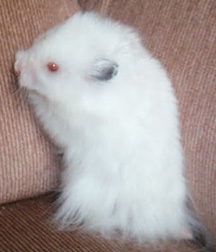
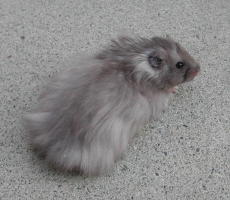
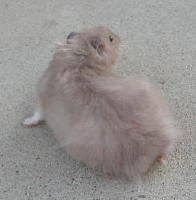
Let's also look at the differences using just the ED gene (using short haireds on the top row and long haireds on the bottom row). On the left, we have two pictures of Homozygous EDs. (This is the wild color, Golden, with only the ED gene.) In the center are two Heterozygous EDs (Golden). On the right we again have a Dark-eared White. You can see that the center hamsters' color is in between that of the two on the left and the DEW on the right.
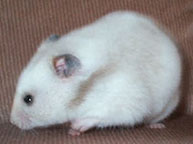
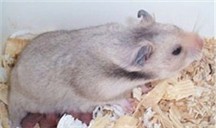

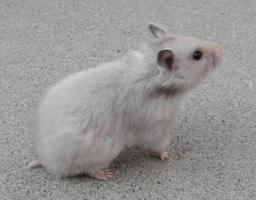
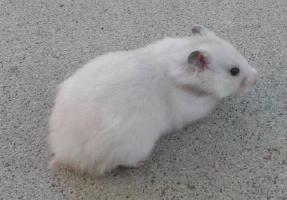
From the River Road Hamstery's site:
Propagation and good development of Extreme Dilute hamsters depends on crossing them into pure Golden lines. The pure Extreme Dilute phenotype is still uncertain in terms of its ideal shading because the original lines were heavily laced with Banded, Umbrous and several color genes. Clouding of the issue by Dark Eared White, present originally and introduced in testing, has been a persistent problem.
Of course, the generation of Extreme Dilute combination colors or heterozygous forms requires these other color genes. Evidence to date suggests that conbinations with Black, Black Eyed Cream and Sable are attractive colors with some merit. (See the Extreme Dilute Photo Gallery.) Extreme Dilute Cinnamon and Heterozygous Extreme Dilutes Cinnamon and Black Eyed Cream seem to offer little more than a dirty white hamster. Unless the heterozygous forms of Black or Golden are desired, care should be taken not to breed to a hamster with a Dark Eared White gene.
Because the ideal shading for the ED colors has not yet been determined, we don't yet have a standard for any of the Extreme Dilute colors. At CHA shows, they will be shown in the Unstandardized class. It will take time and additional matings to identify the ideal shading and develop standards, and the standard for each ED and combination color will be established independently. Additionally, since some Extreme Dilute colors are not particularly attractive, they may never be standardized and rarely even bred.
From the River Road Hamstery site:
"For instances where a breeder is uncertain if a hamster is Extreme Dilute or one of the greys, the definitive cross is to a Dark Eared White. With an Extreme Dilute, the entire litter will be Heterozygous Extreme Dilute or one of its combinations. With a grey, the litter will be all full-colored hamsters unless the grey also carries DEW. The Dark Eared White is also used to differentiate Extreme Dilute from Heterozygous Extreme Dilute. In the former case, the litter will be 100% Heterozygous ED; in the latter, there will be a mix of Heterozygous ED and DEW. Similarly, Dark Eared White can be used to define carriers of the ED allele."
So it is quite easy to identify an Extreme Dilute hamster through breeding -- if the DEW gene is available in your area. Again, the Extreme Dilutes are not too difficult to find on the East Coast of the U.S. They have just made their way to Southern California in the Spring of 2003, so they will slowly become available in this area of the country. They are not known to be in any other areas of the U.S. nor are they known to be in any other countries worldwide.
Sables and Chocolate Sables
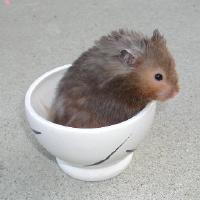
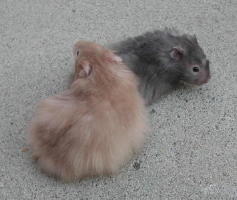
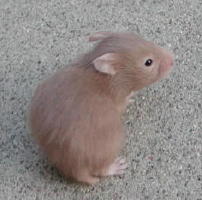
Sables typically brown with age, and the male to the left above is a typical Sable who is browning. He does not have any Rust in his pedigree and can never produce a true Chocolate nor can he produce any of the Extreme Dilute colors above -- unless he is bred to a female with those genes and then their pup carriers are further bred. As a matter of fact, the standard for the Sable was written for a Sable with black tips to its hairs -- to be as close to black as possible. This browning Sable is not close to the ideal color and would only be considered pet quality. He would not be a good breeder (and is actually a rescue hamster).
Chocolate Sables are also different in color than Chocolates or Extreme Dilute Blacks. The center photo above shows a Sable in the back and his Chocolate Sable brother in the front. You can see how the addition of the Rust gene dramatically affects the color. You can also see the faint eye rings in his younger picture -- a feature you do not see in any of the pictures above of Chocolates or ED Blacks. Chocolate Sables tend to lighten with age, but you can see that his color is distinct from that of a Sable even at weaning.